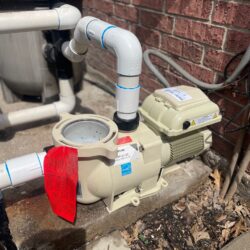How to Troubleshoot a Pool Pump That Won’t Prime
Picture this: It’s a scorcher of a day, and all you can think about is plunging into your pool. But when you flip the switch on your pool pump, it just groans in protest, refusing to pull water. Now, instead of chilling by the water, you’re sweating over how to troubleshoot a pool pump that won’t prime. We’ve all been there—well maybe not with an uncooperative pump but certainly some snag in our laid-back plans.
You might know a bit about pools or pumps—or perhaps you’re more familiar with enjoying the cool waters than maintaining them. No worries; I’m here to help bridge that gap.
I’ll walk you through getting back that sweet hum of properly flowing water so fast it’ll feel like magic. You’ll get why air leaks are troublemakers and how something as simple as cleaning can work wonders for your pipes. So let’s roll up our sleeves and tackle those pesky plumbing issues head-on, ensuring everything runs smoothly again in no time.
Troubleshooting Common Pool Pump Issues
When your pool pump starts acting up, it’s like a hiccup at your pool party. But don’t sweat it. We’re here to help you figure out why your common pool pump is throwing tantrums and how to calm it down.
Identifying Signs of a Failing Pool Pump
Noisy operations can signal trouble; if there’s grinding or humming without action, listen up because these sounds are cries for help from the pump motor. Grinding could mean the bearings inside are on their last leg—think of an old car struggling uphill. A hum with no start-up dance? That might be a bad capacitor pleading for retirement. These issues aren’t just about noise coming from your equipment—they point to larger pump issues that need immediate attention.
If you notice water flow has turned into more of a lazy river than rapids, check the filter pressure and water level in the skimmer box right away. Low pressure means low flow—a sign something’s blocking its groove or perhaps air bubbles have joined the mix through suction leaks. And let’s not forget: watching water seep where it shouldn’t? You’ve got yourself a leak, my friend.
Steps to Resolve Water Flow Disruptions
To get things flowing smoothly again, start by checking simple solutions before diving deeper into troubleshooting waters—for instance removing debris that may have crashed your pump basket party uninvited. If everything looks clean but problems persist, peek under the strainer lid; sometimes o-rings go rogue and need replacing faster than socks disappear in laundry day mystery vortexes.
Beyond clearing clogs and fixing seals lies another possible culprit—the multiport valve could be staging its own mutiny by letting air sneak in instead of keeping water tight as part of team circulation.
When Your Pool Pump Motor Hums but Doesn’t Start
The silent treatment from motors when they should be whirring with life usually points fingers at electrical. Test this theory by giving capacitors an encore performance call—if they’re shot after one-hit wonder days, then replacing them is key. Make sure to swap out any faulty ones so your motor regains its power and leaves silence behind.
The Importance of Proper Pool Pump Priming
Imagine your pool pump as the heart of your swimming oasis, pumping life into those cool, inviting waters. But when that heart can’t get its beat right—aka it won’t prime—you’re in for a not-so-relaxing time. Let’s talk about why priming correctly is crucial and what goes haywire if you don’t nail this process.
How to Prime Your Pool Pump Effectively
You’ve cleaned out the basket but hit a snag: the pool pump won’t prime.
Don’t worry; it takes a bit of finesse to get the pump primed correctly.
First up, make sure that strainer lid is on tight—with no debris messing with the seal—and give that cover o-ring some love with lubrication to prevent air leaks. An unprimed pump could mean air bubbles are crashing your pool party or worse—a dry run can lead to overheating.
Now check for water coming from any odd places—it shouldn’t be. Water dripping means trouble like a suction leak somewhere between your skimmer and pump housing. Make sure everything’s snug—from those hose connections down to every clamp and fitting along the way.
If you hear gurgling sounds or see bubbles coming back through returns while trying to pull water through your system, suspect an air leak wreaking havoc upstream from where water enters your pump—or maybe even at that pesky multiport valve on top of the filter tank (we’ve all been there).
Troubleshooting a Pool Pump That Won’t Prime
Air relief valves aren’t just nifty gadgets—they’re little lifesavers when you’re dealing with priming woes because they let trapped air escape so water can take its rightful place in line for a splashy rendezvous inside your filtration system. However, sometimes these guys stick or malfunction leaving us scratching our heads wondering why we have more airflow than actual flow-through.
But before blaming faulty equipment outright remember: successfully priming doesn’t guarantee all systems are go—your pool plumbing might be fine but electrical gremlins could still lurk unseen causing intermittent issues especially after powering off then back on again which leads me directly into my next point…
Maintaining Your Pool Pump for Longevity
Let’s be honest, nobody desires to take a plunge in what appears like a bog beast’s hot tub. So keeping your pool pump running smoothly is crucial unless you’re into murky waters and unexpected repair bills.
Cleaning and Replacing the Skimmer Basket
Your skimmer basket might not get as much attention as the latest celeb gossip, but neglecting it can lead to some serious drama in your pool system. Imagine this: It’s like trying to suck tapioca pearls through a straw if they clog up – nothing moves. That’s why cleaning out that skimmer basket regularly is key. And when I say ‘regularly,’ I mean more often than you’d check your phone notifications.
To keep things flowing smoother than an otter on a water slide, give that basket sits area regular once-over. If debris has thrown a party there, evict those unwanted guests by emptying the contents and giving it a good hose down. Now, if you spot cracks or breaks—and let me tell ya’, cracked baskets are about as useful as screen doors on submarines—then replace them pronto. Here’s where we help customers avoid future headaches; remember that even small damage can lead to big problems over time with overheating pool pumps because of restricted water flow.
Checking and Replacing the Shaft Seal
If spotting water seep around your pump feels akin to finding out someone spilled soda on your new couch—it’s time for detective work. The shaft seal may have decided its job was too hard and started letting leaks sneak past its defenses which could spell disaster for both motor bearings (because no one likes rusted internals) or worse – cause complete system failure.
Luckily swapping out these little guys isn’t rocket science; just be sure power is off before playing surgeon with any part of electrical equipment otherwise things might go from bad-to-“fried hair” real fast…and not in good way either folks. But seriously though here’s how easy changing them should be: Unscrew pump cover carefully without dropping screws into abyss below then pull old seal off using proper tools avoiding Hulk-like force since brute strength doesn’t always win day here…
Understanding Pool Pump Components and Their Functions
An overview of each part of a pool pump and its role in ensuring clean and clear swimming pool water.
The Dynamic Duo: Pump Basket and Strainer Box
The strainer box acts as the first line of defense against debris, with its partner-in-crime—the pump basket—catching leaves, twigs, or any other unwanted particles before they can enter the heart of your system. Think of them as Batman and Robin keeping Gotham safe; without these two doing their job right at the entrance gate (your skimmer), chaos could ensue inside your pristine waters.
A clogged or damaged basket will call for quick action because let’s face it – no one likes a dirty pool. Make sure you check it regularly; otherwise, those little bits might throw off our hero’s game.
Suction Side Savvy: The Skimmer Basket Sits Ready
Moving on to where water gets pulled from – if we peek into our pools’ depths by lifting that skimmer lid up top next to our deck (careful now), we’ll find another heroic gadget quietly sitting there—the skimmer basket. It serves diligently catching stuff before it heads down through pipes towards more sensitive areas such as pumps or filters.
If you see bubbles coming out when jets should be flowing smoothly? That may signal air getting sucked in somewhere along lines—which means trouble brewing below surface level. To avoid an overheating pool pump situation due to blockages causing strain on motors among others things…well just make sure nothing escapes past this vigilant keeper.
The Gatekeeper: Lid O-Ring Seals The Deal
Next up is something small but mighty -the lid o-ring seals atop both baskets mentioned earlier ensure everything stays tight so no air sneaks through cracks leading us back into dreaded bubble territory again while also preventing water dripping everywhere else except where intended within circulation paths designed specially by engineers behind scenes…
So remember folks always inspect these rings whenever opening covers since wear/tear over time does happen especially under blazing sun during peak summer days.
FAQs: Troubleshoot a Pool Pump That Won’t Prime
What would cause a pool pump not to prime?
Air leaks, clogged filters, or low water levels can keep your pump from priming. Check for cracks and blockages first.
Why is my pool pump not filling up with water?
Your skimmer basket might be full, or the main drain could be blocked. Clear any debris you find to get things flowing.
Why won’t my pool pump build pressure?
A faulty seal or cracked pipe may lead to air getting in and killing the pressure. Inspect and replace as needed.
How do I know if my pool pump impeller is clogged?
If there’s weak flow or it’s making strange noises, check your impeller for gunk—gloves on; it could get messy.
Contact WaterTex Pools
Now you’ve got the know-how. How to troubleshoot a pool pump that won’t prime should be clearer, and keeping your swimming oasis running flawlessly isn’t just a dream.
Remember: air leaks are silent culprits; always check for them first. Cleaning is more than housekeeping—it’s preventative maintenance for your pool pump.
Troubleshooting isn’t daunting when you break it down step by step. From priming effectively to identifying those warning hums, each move brings you closer to resolution.
Maintenance matters—keep skimmer baskets clean and shaft seals checked regularly. These simple acts can save you from headaches later on.
Dive into these tips whenever trouble strikes, and soon enough, your biggest worry will be getting too much sun as you float in clear waters once again.

